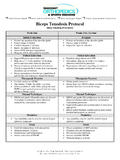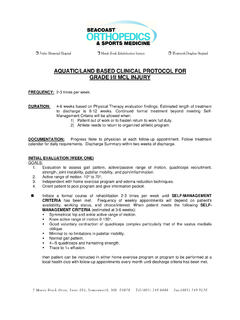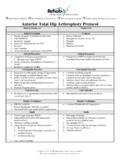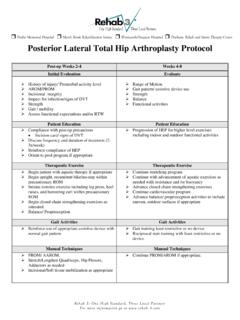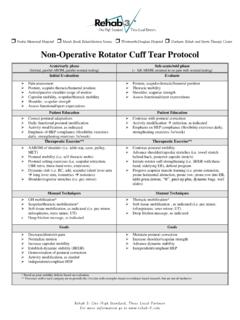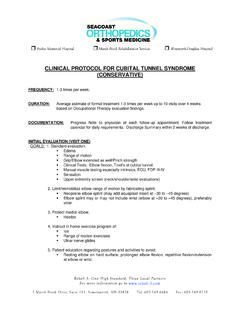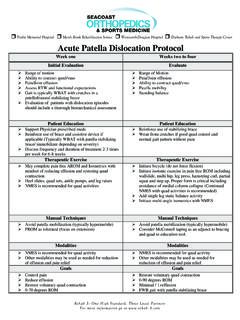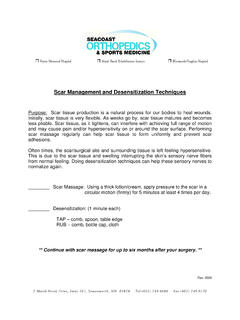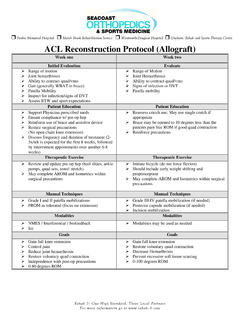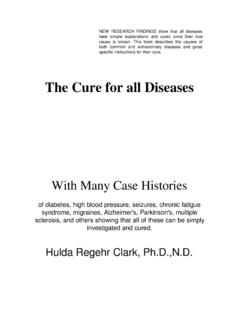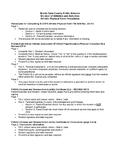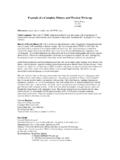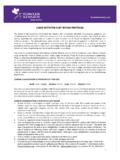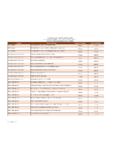Transcription of REHAB 3 CLINICAL PROTOCOL FOR - SOS Med
1 Frisbie Memorial Hospital Marsh Brook Rehabilitation Services Wentworth-Douglass Hospital CLINICAL PROTOCOL FOR LUMBAR FUSION AND DEBRACING. FREQUENCY: 2-3 times per week. DURATION: Average estimate of formal treatment 2-3 times per week for 2-3 months with patient participating in Transitional Rehabilitation Program once independent with Phase III and until debracing can begin. Then, resume formal therapy 2-3 times per week for 4-6 weeks or until fully debraced. DOCUMENTATION: Progress Note to physician at each follow-up appointment. Follow treatment calendar for daily requirements. Discharge Summary within 1 week of discharge. PHASE ONE (PRE-OP TO 2 WEEKS POST-OP). Pre-Op Visit: 1. Teach initial stretching and strengthening exercises per Home Exercise Program for Fusion.
2 Patient to start with isometric abdominal, fusion single knee to chest, partial sit-up, spine elongation, and bridging on post-op Day 2 progressing toward all exercises by end of post-op Week 2. Begin with 5. repetitions 2-3 times per day progressing toward goal of 30 repetitions once daily. Initiate walking program with a goal of a 1 mile walk in 30 minutes by 4 weeks post-op. 2. Review post-op precautions. Give patient "Life After Fusion" booklet. All precautions listed on Pages 1/2. 3. Review transfers/position transitions, log rolling to sit up/lie down, and avoidance of increased hip flexion with sit to stand. 4. Icing 10-15 minutes as needed throughout the day. Apply lying down in bed. Roll in/out of brace. Post-Operative Evaluation (Post-Op Day 14): GOALS: 1.
3 Evaluation to assess: ADL status. Adaptive equipment provision/OT consult if necessary. Posture and function. pain /Inflammation. Incisional integrity. Gross upper and lower extremity flexibility and strength. DO NOT assess lumbosacral flexibility or hip flexion beyond 90 degrees until debraced! Knowledge of and compliance with precautions and wearing of brace. 2. Postural education, body mechanics, and transfers. 3. Review home exercise program/edema reduction techniques. Initiate formal rehabilitation 2-3 times per week until SELF-MANAGEMENT CRITERIA has been met. Frequency of weekly appointments will depend on patient's availability, working status, and choice/interest. When patient presents with the following SELF-MANAGEMENT CRITERIA: Prior to debracing: 1.
4 Compliance with post-op precautions, brace wear, and body mechanics. 2. Compliance with home exercise program. 3. Independent with clinic strengthening and cardiovascular program. 4. Independent pain management techniques with stable symptoms. Following debracing: 1. Compliance with home exercise program. 2. Independent with clinic strengthening and cardiovascular program. 3. Independent pain management techniques and stable symptoms. then patient can be instructed in a home exercise program and Transitional Rehabilitation Program at REHAB 3 with follow-up appointments every 2-3 weeks until debracing begins or Discharge Criteria has been met. 7 Marsh Brook Drive, Suite 101, Somersworth, NH 03878 Tel:(603) 749-6686 Fax:(603) 749-9270.
5 2. DISCHARGE CRITERIA (4-6 MONTHS POST-OP). Functional trunk range of motion and strength. Demonstrates excellent posture and body mechanics. Independent pain management techniques. Fully debraced. Proficiency in self-management program. Functional goals met or consistently progressing toward. Failure to comply. Failure to progress. chronic pain behavior is present. {As defined by Minnesota Worker's Compensation treatment Parameter Rules part , subpart 3. chronic pain Syndrome is any set of verbal or non-verbal behaviors that: - involve the complaint of enduring pain ;. - differ significantly from the patient's preinjury behavior;. - have not responded to previous appropriate treatment ;. - are not consistent with a known organic syndrome which has remained untreated; and - interfere with physical, psychological, social, or vocational functioning.}
6 Therapist discussion with physician is necessary to discharge patient from Physical Therapy due to chronic pain behavior so that appropriate post discharge treatment plan can be initiated. -- treatment GUIDELINES-- PHASE II (POST-OP WEEKS 2-6). GOALS: (To be met at least at end of time frame.). 1. mile walk in 30 minutes daily. 2. 30 repetitions of home exercise program once daily on non-therapy days. Instruct in lumbar stabilization techniques. Instruct patient in maintaining neutral spine position within brace. Initiate cardiovascular training. Treadmill 5-7 minutes warm-up, progress to 15-20 minutes endurance training. UBE 4-5 minutes, progressing to 10-15 minutes at 60 degrees/second. Avoid bicycle. No onset of leg pain allowed or increase in pain if persistent post-operatively with any exercise.
7 Rate pre-exercise back pain on 10 point scale. pain may increase "2" points not to exceed a maximum of "8" over the course of the visit but should return to baseline within 1 hour of completing workout. Decrease speed or weights to stay within allowed pain range. Pre-Workout Stretches = Three 20 second repetitions for each: Quadriceps in sidelying or standing, hamstring on stool, standing calf, lats, posterior shoulder, and trapezius. DO NOT PERFORM: A. Knees to chest B. Abductor stretch with leg elevated in abduction C. Trunk rotation D. Hamstring stretch in supine E. Iliopsoas stretch Selectorized Weight Training Machines: 1. Avoid 90 degrees hip flexion on leg press for long fusions (L1 or L2 to the sacrum). 2. PT staff must push pedals down for patients on fly and chest press.
8 3. PT staff must set seats for patients if unable to be done within hip flexion and lifting precautions. 4. Weight lifting technique: A. Each machine must be properly fitted to the patient's trunk and limb length. B. Resistance should be adjusted so that the patient can perform 15 repetitions with moderate muscle fatigue, single set. C. Weights should be lifted up within 2 seconds, held there for 1 second, and then lowered slowly within 4 seconds. 3. PHASE II (POST-OP WEEKS 2-6) continued 5. Weight training progression: A. Progress repetitions to 20. When patient can complete 20 repetitions at a given resistance, using good technique for 3 workouts in succession, the resistance may be increased to 1 plate or by 5%. B. The patient will be scheduled to weight train 2-3 times per week.
9 They will be expected to walk and perform home exercise program on non-weight training days. C. PT staff may limit the maximal amount of weight that a patient may lift on any machine. D. Symptom changes and complaints should be evaluated by therapist before the session begins so that the program may be adapted appropriately. 6. Initiate back strengthening: Lat pull down, upright rows, back extension. Lower extremity machines: Knee extension, seated leg curl avoiding full leg extension, leg press, and calves on Trotter equipment or Total Gym. Upper extremity exercises: Chest press and fly with assistance to use foot pedal, triceps press on lat pull, and bicep curls unilaterally in sitting or standing with dumbbells. PHASE III (POST-OP WEEKS 6-12).
10 GOALS: (To be met at least at end of time frame.). 1. 30 minutes of cardiovascular exercise at target heart rate by utilizing treadmill, UBE, and/or stairmaster. If using stairmaster, use stool to get on and off watching hip precautions. Add multi-hip machine. Follow post-fusion PROTOCOL until physician determines debracing should begin. Patient can go to Transitional Rehabilitation Program as soon as independent with clinic program until debracing can begin. PHASE IV (POST-OP MONTHS 3-5 TO DISCHARGE). DEBRACING GOALS: (To be met at least at end of time frame.). 1. Meet Discharge Criteria. 2. Fully debraced no sooner than 2 weeks or later than 4 weeks. WEEK 1. 1. Begin sleeping without brace. 2. Begin removing brace 15 minutes BID during sedentary activity.

